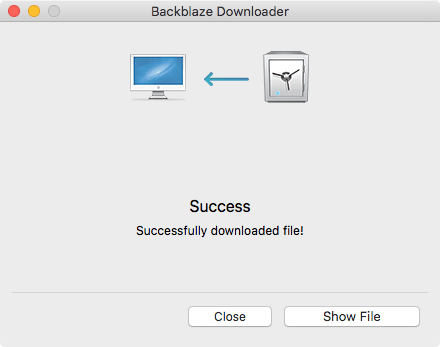

I’ve got a single USB cable running under my desk to a powered USB hub, which in turn connects to the 4TB Seagate drive. Time Machine remains an excellent way to back up your data and recover individual files if things go wrong. So what am I doing with these drives you may ask? The answer is, redundant backups.

I also own a single 4TB version of the same drive.

They are small and light, and they are USB-powered.
Backblaze backup external drive portable#
I’ve bought three separate Seagate portable 5TB drives. My data needs are just under 5TB right now, and there are several affordable 5TB storage options. One of the reasons I spent time ditching files was so I could keep it simple. If you have more data to back up than will fit on the current affordable drive capacity, you’ll need to split your data or look at a more complex NAS system. Ideally, you want your backup to fit within that sweet spot where it can be contained on an affordable drive. But if you don’t, backing up can be a lot easier with a smaller load.Īt any particular time, there is a curve for hard drive storage in price. If you need 20TB of data, by all means keep it. By thinning down my library, I substantially decreased the complexity of my backup system. The bigger your digital footprint is, the more complex the backup system gets. I am not advocating throwing away files that you need but instead looking closely at those files that you keep to see if you really need them or not. I contacted those clients, returned the data to them, and then removed it from my own system, again reducing my overall data footprint. I also did legal work on some disputes that had real data-heavy file storage. They’re older now, and they are not quite as interested in the Barbie Princess movies as they used to be, so those and a lot of other files went to the digital graveyard. Small kids watch the same movies over and over again and frequently seem to have peanut butter on their fingers, which is not very DVD-friendly. When my kids were younger, I ripped a lot of DVDs. I should mention that last year that number was closer to 7TB, but I did an audit of what files I actually still needed and ended up throwing out a lot of old files. I’m currently using about 3TB of that, making my working digital footprint just south of 5TB total, all on internal and external SSD. It is also too small for all my ones and zeros, so I have an attached external SSD that is in an OWC enclosure giving me an additional 4TB of data. That’s enough room to store my Photos Library, all client files, and all working files on whatever Field Guide I’m currently working on. It has a 2TB internal SSD from which I do all active work on. This is the machine I spend the most time at every day. My Mac, my precious, is the center of my computing world. The good news is that it is easier than ever. I talk about backup so much because I often hear the horror stories from listeners and readers that compel me to remind everyone to keep backing up. Backups! The thing that us nerds love to talk about, right? Not really.


 0 kommentar(er)
0 kommentar(er)
